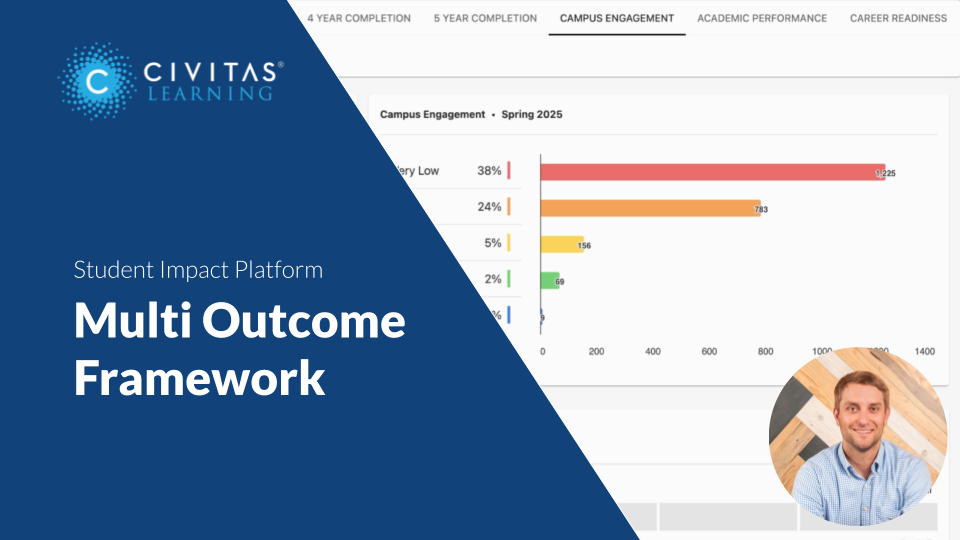
4 Ways to Get Faculty to Partner on Student Success
Share this Post
Faculty play a central role in building connections with students. Their regular interaction and academic and career guidance, especially within their areas of expertise, can significantly help students in their college experience. As Inside Higher Ed notes, “Students often turn to their faculty members for advice and support outside of academics, including career advice and mental health support, so positive student-faculty relationships are a critical piece of student success.”
However, not all faculty members are equipped to positively impact their student’s academic journey. By investing time and resources into supporting faculty, higher education institutions can help bridge academic and systemic gaps by:
- Addressing Academic Gaps: Offering professional development helps faculty become stronger instructors, improves early alert communication, and enhances student outcomes.
- Addressing Systemic Gaps: Institution-specific analytics can more accurately project course demand for future planning and identify opportunities to offer tailored academic support for challenging courses.
It is crucial to adequately train faculty to deliver high-quality instruction and provide them with simple strategies to connect students to resources. Here are four ways Civitas Learning partner institutions integrate faculty into the student success efforts for improved outcomes:
- Build an Authentic Partnership
Engaging faculty in student success can be challenging for institutions of any size. Barriers such as siloed systems or entrenched processes from previous leadership can limit visibility into student behavior and performance—key factors for driving successful outcomes. Additionally, the longstanding approach of advising or programs like tutoring managing student success often leaves faculty isolated and disengaged from this important part of the student experience.
To overcome these obstacles, engaging faculty early and often when adopting new student success strategies is essential, rather than simply announcing or educating on decisions, policies, and new initiatives. Austin Community College (ACC) models this approach by involving faculty from the beginning in designing their early alert system. Dr. Ruth Reinhart, Associate Vice Chancellor of Student Support Services at ACC, explains:
“From the onset, we found partners in instruction and asked, ‘Help us build what would help you support students in the classroom. You are the experts.’”
This collaborative approach made it simpler for faculty to integrate the system in their day-to-day practices and share its value to peers. They feel empowered to work together with other support staff, such as academic advisors, mentors, and tutors, and connect students with the right resources across campus.
SUNY Broome faced a similar challenge: they needed a more effective way to engage faculty and help all stakeholders gain a clear view of student performance and behavior. Recognizing the crucial role faculty insights play in evaluating students’ academic goals and targeting support for specific groups, administrators introduced innovative strategies to secure faculty buy-in. These strategies included providing financial incentives through grant funding, establishing a faculty mentor model, and creating diverse working groups to encourage shared decision-making—not just once, but consistently throughout the year.
- Identify Opportunities for Professional Development
When new processes or technologies are introduced, training is often a one-time event, leaving gaps in understanding or diminishing its perceived importance as an ongoing part of faculty work. Providing continuous training and opportunities for faculty to expand their instructional and student support skill set is crucial for improving student outcomes.
The 2023 Civitas Learning Impact Report analyzed over 500 initiatives affecting more than 3.9 million students at 48 institutions and revealed a clear message: stronger faculty leads to better student outcomes. Investing in faculty development resulted in a significant 11.4% increase in student persistence—an impact greater than many traditional initiatives like advising or scholarships.
Certifications and ongoing training on student success practices and opportunities to refine classroom presence and instruction are especially impactful as faculty interact with students daily. For example, training faculty to respond to students in crisis and guide them to appropriate resources is a critical aspect of the student success journey.
ACC is making adoption easier by offering ongoing faculty training and video tutorials they can reference afterward. Training is offered in various modalities to meet instructors where they are. Hilda Garke, Coordinator of Student Affairs Training, shares other ways they provide guidance on faculty training:
“Our faculty teaching and learning division has created a website with a detailed FAQ page covering everything from how to log in to what an alert looks like and how to respond. It takes just five minutes to get up to speed. They can always reach out to me for extra training. It’s user-friendly, and we’ve seen very high adoption rates.”
Educating faculty about their essential role in student success helps them better understand students’ classroom behavior, personal commitments, and extracurricular activities. This awareness enables faculty to more effectively support their students in the classroom and guide them toward the resources they need to be successful.
- Pinpoint Curricular Bottlenecks for Early Intervention
When faculty leaders put their time, energy, and expertise into designing a curriculum, the last thing they want is for a course to be a barrier to graduation. To prevent this, it’s crucial to have insights into which courses most impact persistence and completion and benefit from wrap-around support like supplemental instruction. This broader perspective helps pinpoint systematic barriers and enables proactive interventions.
DFW rates often measure course difficulty, but relying on a single data point can provide an inaccurate view of a course’s impact on student success. Administrators and department leaders require more detailed insights into how individual courses impact student outcomes. They need to pinpoint the influence of specific classes on persistence and completion to identify opportunities to enhance academic support and curriculum sequences.
For example, a partner institution used course insights to identify that a mandatory first-term course, English 1301, was a major barrier to students persisting to the next term. With this knowledge, they quickly rolled out interventions to improve student performance. This initiative fostered collaboration among course instructors, departmental chairs, and the advising team, who identified that many students were academically underprepared and highlighted specific skills that needed improvement. As a result, advisors could offer more targeted support, including APA instruction and writing workshops.
Similarly, UTSA uses course insights to collaborate with faculty to identify misalignments in the curriculum and understand how their course impacts student outcomes. When students are underprepared for a course, it signals the need for additional support, such as adding a prerequisite or offering more office hours or tutoring options. The ability to identify when and where there is a decrease in persistence within the curriculum helps academic leaders customize interventions.
- Empower Academic Leaders to Easily Monitor Course Demand
Accurately tracking course demand and proactively monitoring enrollment needs has often been overlooked. Many academic leaders manually monitor course enrollment, roll over schedules from the previous term, and add extra course sections at the last minute to meet demand during registration periods. However, this method can result in a mismatch between student needs and the courses offered by the institution, leading to issues such as a lack of qualified faculty for additional sections or cancellations due to low enrollment.
As student interests and market demands evolve, relying on past data will not yield an accurate course schedule that meets student needs. By consolidating historical, current, and future enrollment data in one central location, academic leaders can gain valuable insights into enrollment patterns and real-time course demand. This allows them to understand trends and anticipate changes, ultimately improving course offerings and avoiding the costs associated with under-enrolled courses.
With accurate course demand forecasts, leaders can decide when to open new sections based on institution-specific insights rather than standard practice.
These insights, available before the term begins, help prevent empty seats or, more importantly, not having a required course available that could delay a student’s path to graduation. Providing tools that allow faculty to easily monitor course capacity before classes begin leads to better use of faculty time and optimized institutional resources.
——————–
Faculty are often the first to notice students who need guidance or support, and their influence extends beyond the classroom to provide academic, career, and personal advice and mentoring. Institutions must build authentic partnerships, offer ongoing professional development, and provide the right tools for early intervention to maximize their impact. If your institution faces faculty engagement challenges, know that you’re not alone. You can foster meaningful collaboration and drive better student outcomes with the right approach.



